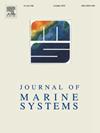Trend analysis of time series variations in the marine environments and size-fractionated chlorophyll a in the coastal areas of eastern Hokkaido, southwestern Okhotsk Sea
IF 2.5
3区 地球科学
Q2 GEOSCIENCES, MULTIDISCIPLINARY
引用次数: 0
Abstract
The coastal areas of eastern Hokkaido, located in the southwestern part of the Okhotsk Sea, are unique areas where the Soya Warm Current Water (SWCW) and the East Sakhalin Current Water (cold water) alternate seasonally. They are important sea areas for Japanese fishery production. Observational results off Cape Notoro, eastern Hokkaido, over the last 10 years (2011−2022), showed that the influence of the Tsushima Warm Current Water (TWCW), the origin of the SWCW, has become stronger. The TWCW is dominated by small phytoplankton. An increase in their impact will have a similar effect on the ecosystem in the SWCW, where large phytoplankton dominate, as the shift to small phytoplankton occurs owing to global warming. Although the change in small phytoplankton observed in the current study was not statistically significant, the standing stock of small phytoplankton has been high over the past few years. An increase in the influence of the TWCW and a shift to small phytoplankton were observed in Saroma-ko Lagoon (2009–2022), the largest brackish-water lake in eastern Hokkaido. Data from the past 35 years (1987–2021) indicated a significant increase in the surface water temperature. Furthermore, off Shibetsu in the Nemuro Strait on the east side of the Okhotsk Sea across the Shiretoko Peninsula (2009–2022), the influence of the TWCW strengthened and indications of a shift to small phytoplankton were found. This study showed that in the phytoplankton community, the significance of small phytoplankton as primary producers has risen in response to environmental changes such as global warming and the growing inflow of the TWCW, in the coastal areas of eastern Hokkaido in the Okhotsk Sea. There have been concerns regarding future changes in the ecosystems and fishery production. Therefore, it is essential to continue monitoring studies for sustainable fishery production.
北海道东部、鄂霍次克海西南部沿海海域海洋环境和叶绿素a大小分异时间序列变化趋势分析
位于鄂霍次克海西南部的北海道东部沿海地区是大豆暖流(SWCW)和东库页岛暖流(冷水)季节性交替的独特地区。它们是日本渔业生产的重要海域。近10年(2011 ~ 2022年)北海道东部诺托罗角海域的观测结果表明,作为对马暖流起源的对马暖流(TWCW)的影响越来越强。TWCW以小型浮游植物为主。随着全球变暖导致浮游植物向小型浮游植物的转变,它们的影响的增加将对SWCW的生态系统产生类似的影响。在SWCW,大型浮游植物占主导地位。虽然本研究中观察到的浮游植物的变化没有统计学意义,但在过去的几年里,浮游植物的存量一直很高。在北海道东部最大的咸水湖Saroma-ko泻湖(2009-2022年)观察到TWCW的影响增加,并向小型浮游植物转移。过去35年(1987-2021)的数据表明,地表水温度显著升高。此外,在鄂霍次克海东侧横跨Shiretoko半岛的Nemuro海峡的Shibetsu附近(2009-2022年),发现TWCW的影响增强,并有向小型浮游植物转移的迹象。研究表明,在鄂霍次克海北海道东部沿海地区,小型浮游植物作为初级生产者的重要性随着全球变暖和TWCW流入增加等环境变化而上升。人们一直担心生态系统和渔业生产的未来变化。因此,必须继续对可持续渔业生产进行监测研究。
本文章由计算机程序翻译,如有差异,请以英文原文为准。
求助全文
约1分钟内获得全文
求助全文
来源期刊

Journal of Marine Systems
地学-地球科学综合
CiteScore
6.20
自引率
3.60%
发文量
81
审稿时长
6 months
期刊介绍:
The Journal of Marine Systems provides a medium for interdisciplinary exchange between physical, chemical and biological oceanographers and marine geologists. The journal welcomes original research papers and review articles. Preference will be given to interdisciplinary approaches to marine systems.
 求助内容:
求助内容: 应助结果提醒方式:
应助结果提醒方式:


